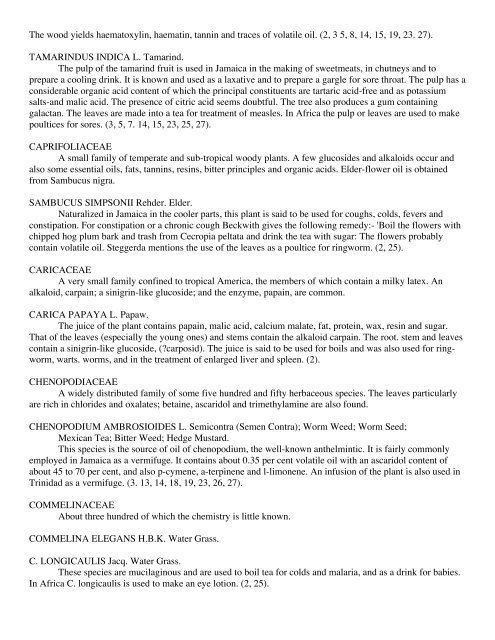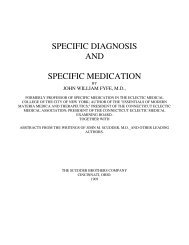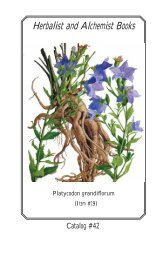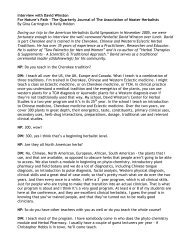MEDlCINAL PLANTS OF JAMAICA. PARTS 1 & 11.
MEDlCINAL PLANTS OF JAMAICA. PARTS 1 & 11.
MEDlCINAL PLANTS OF JAMAICA. PARTS 1 & 11.
Create successful ePaper yourself
Turn your PDF publications into a flip-book with our unique Google optimized e-Paper software.
The wood yields haematoxylin, haematin, tannin and traces of volatile oil. (2, 3 5, 8, 14, 15, 19, 23. 27).<br />
TAMARINDUS INDICA L. Tamarind.<br />
The pulp of the tamarind fruit is used in Jamaica in the making of sweetmeats, in chutneys and to<br />
prepare a cooling drink. It is known and used as a laxative and to prepare a gargle for sore throat. The pulp has a<br />
considerable organic acid content of which the principal constituents are tartaric acid-free and as potassium<br />
salts-and malic acid. The presence of citric acid seems doubtful. The tree also produces a gum containing<br />
galactan. The leaves are made into a tea for treatment of measles. In Africa the pulp or leaves are used to make<br />
poultices for sores. (3, 5, 7. 14, 15, 23, 25, 27).<br />
CAPRIFOLIACEAE<br />
A small family of temperate and sub-tropical woody plants. A few glucosides and alkaloids occur and<br />
also some essential oils, fats, tannins, resins, bitter principles and organic acids. Elder-flower oil is obtained<br />
from Sambucus nigra.<br />
SAMBUCUS SIMPSONII Rehder. Elder.<br />
Naturalized in Jamaica in the cooler parts, this plant is said to be used for coughs, colds, fevers and<br />
constipation. For constipation or a chronic cough Beckwith gives the following remedy:- 'Boil the flowers with<br />
chipped hog plum bark and trash from Cecropia peltata and drink the tea with sugar: The flowers probably<br />
contain volatile oil. Steggerda mentions the use of the leaves as a poultice for ringworm. (2, 25).<br />
CARICACEAE<br />
A very small family confined to tropical America, the members of which contain a milky latex. An<br />
alkaloid, carpain; a sinigrin-like glucoside; and the enzyme, papain, are common.<br />
CARICA PAPAYA L. Papaw.<br />
The juice of the plant contains papain, malic acid, calcium malate, fat, protein, wax, resin and sugar.<br />
That of the leaves (especially the young ones) and stems contain the alkaloid carpain. The root. stem and leaves<br />
contain a sinigrin-like glucoside, (?carposid). The juice is said to be used for boils and was also used for ringworm,<br />
warts. worms, and in the treatment of enlarged liver and spleen. (2).<br />
CHENOPODIACEAE<br />
A widely distributed family of some five hundred and fifty herbaceous species. The leaves particularly<br />
are rich in chlorides and oxalates; betaine, ascaridol and trimethylamine are also found.<br />
CHENOPODIUM AMBROSIOIDES L. Semicontra (Semen Contra); Worm Weed; Worm Seed;<br />
Mexican Tea; Bitter Weed; Hedge Mustard.<br />
This species is the source of oil of chenopodium, the well-known anthelmintic. It is fairly commonly<br />
employed in Jamaica as a vermifuge. It contains about 0.35 per cent volatile oil with an ascaridol content of<br />
about 45 to 70 per cent, and also p-cymene, a-terpinene and l-limonene. An infusion of the plant is also used in<br />
Trinidad as a vermifuge. (3. 13, 14, 18, 19, 23, 26, 27).<br />
COMMELINACEAE<br />
About three hundred of which the chemistry is little known.<br />
COMMELINA ELEGANS H.B.K. Water Grass.<br />
C. LONGICAULIS Jacq. Water Grass.<br />
These species are mucilaginous and are used to boil tea for colds and malaria, and as a drink for babies.<br />
In Africa C. longicaulis is used to make an eye lotion. (2, 25).







